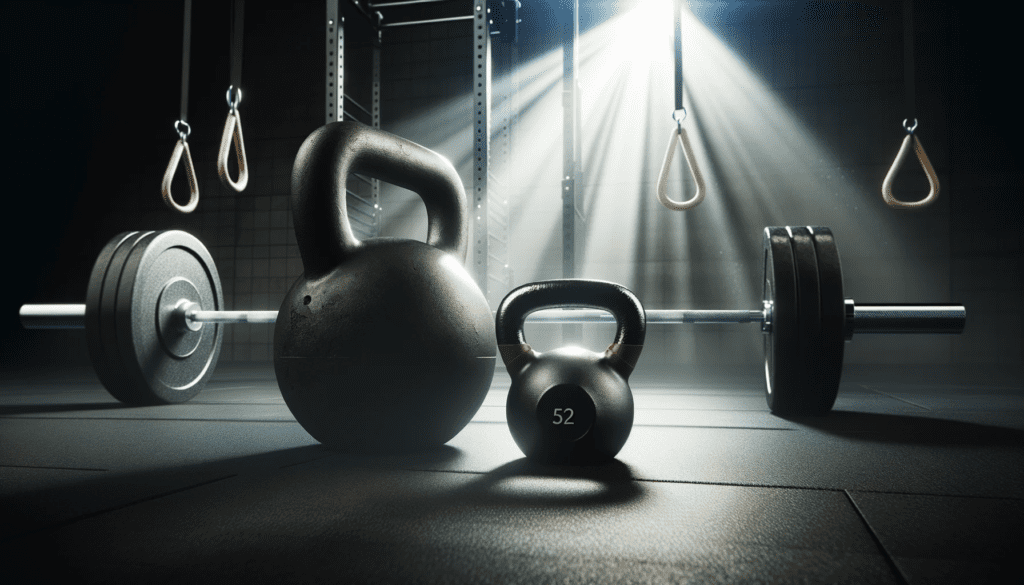Have you ever stood in a gym, staring at a barbell and a kettlebell, and wondered which one would give you the best bang for your buck? You’re not alone.
The kettlebell vs barbell debate has been a hot topic in the fitness community for years.
Both pieces of equipment offer unique benefits, but which one is right for you?
In this comprehensive guide, we’ll dive deep into the world of barbells and kettlebells to help you make an informed decision.
So, let’s get lifting!
On This Page
Key Takeaways
- Barbells are excellent for building raw strength and are used in weightlifting and powerlifting.
- Kettlebells offer versatility and are great for functional fitness and full-body workouts.
- Your choice between a barbell and a kettlebell should align with your fitness goals, whether it’s muscle gain, weight loss, or athletic performance.
- Safety is paramount; proper form and technique are crucial regardless of the equipment you choose.
- Both barbells and kettlebells have their place in a well-rounded training program.
Barbells
When it comes to lifting heavy and building raw strength, barbells are often the go-to piece of equipment.

They’re a gym staple and for a good reason. Let’s delve into what makes barbells a popular choice among beginner and advanced lifters.
What They Are
Barbells are long bars made of steel, often with weight plates added to each end. They’re a staple in any gym and are primarily used for strength training.
They can be used for a variety of exercises, from squats to bench presses.
Benefits
- More Stable Than Kettlebells – Barbells are more stable than kettlebells for most strength training movements.
- Strength Gains – They are excellent for compound movements like squats and deadlifts, which are crucial for building strength.
- Progressive Overload – It’s easy to add weight in small increments, allowing for progressive overload, a key factor in strength training.
Drawbacks
- Learning Curve – Proper form is crucial, and it can take time to master.
- Safety Risks – Without proper form, you’re at risk for injury.
- Limited to Strength – Barbells are primarily designed for strength training and hypertrophy, they aren’t as versatile for other types of training like cardio or functional fitness.
Types of Exercises
- Squats – Great for building quad, glute, and core strength.
- Deadlifts – Excellent for building glute, hamstring, posterior chain, and core strength.
- Bench Press – Builds strength through the chest, shoulders, and triceps.
- Overhead Press – Works the shoulders, triceps, and core.
Kettlebells
Ah, kettlebells—the cannonballs with handles that you’ve probably seen people swinging around at the gym.

They might look a bit intimidating, but they’re a versatile piece of equipment that can offer a range of benefits. Let’s dive into the nitty-gritty of kettlebells.
What They Are
Kettlebells are cast iron or steel balls with a flat base and a handle on top. They’re used for a variety of exercises that combine strength training, flexibility, and cardiovascular fitness.
Benefits
- Full-Body Workout – Kettlebells engage multiple muscle groups at once, offering a comprehensive workout.
- Functional Fitness – They’re excellent for mimicking real-world movements, and improving your functional fitness.
- Space-Efficient – Unlike barbells, kettlebells take up very little space, making them ideal for home gyms.
Drawbacks
- Learning Curve – While they’re versatile, kettlebells have a learning curve, especially for exercises like the kettlebell swing or snatch.
- Limited for Heavy Lifting – While you can lift heavy with kettlebells, they’re not as conducive to max strength development as barbells. This is mainly due to the stability and grip demands.
- Cost – Quality kettlebells can be pricey, especially if you need multiple weights.
Types of Exercises
- Kettlebell Swing – A classic move that works your entire posterior chain.
- Goblet Squat – Great for your quads and glutes.
- Turkish Get-Up – A complex move that engages almost every muscle in your body.
- Kettlebell Snatch – A ballistic exercise that improves explosive strength.
Barbell vs Kettlebell – The Basics
Alright, you’ve got the lowdown on barbells and kettlebells individually. But how do they stack up against each other?

Let’s break down the basics, comparing weight distribution, learning curve, and cost to help you make an informed decision.
| Factors | Barbells | Kettlebells |
|---|---|---|
| Weight Distribution | Weight is evenly distributed, allowing for balanced lifts. Useful for exercises requiring symmetry. | Weight is concentrated in the ball, engaging stabilizer muscles and adding challenge. |
| Learning Curve | Mastering form can take time but is generally straightforward for basic exercises like deadlifts and squats. | Requires more finesse and technique, especially for dynamic movements like swings and snatches. |
| Cost | Initial investment can be high, especially with additional equipment. Durable and long-lasting. | Generally cheaper per piece but can add up for various weights. Also a long-lasting investment. |
Kettlebell vs Barbell – Muscle Engagement
Muscle engagement is a big deal when you’re choosing between barbells and kettlebells.
After all, you want to get the most bang for your buck—or should I say, the most flex for your reps?
Let’s dissect how each of these tools engages your muscles and serves your fitness goals.
| Aspect | Barbells | Kettlebells |
|---|---|---|
| How Each Engages Different Muscle Groups | Better for training multiple muscle groups at once but also allows for the isolation of specific groups like biceps or quads. | Focuses on full-body engagement, often using multiple muscle groups in a single exercise like the Turkish Get-Up. |
| Compound vs Isolation Exercises | Excellent for compound exercises like squats and deadlifts. Can also be used for isolation exercises like bicep curls. | Generally better for compound exercises that engage multiple muscle groups and joints. Isolation exercises are less common. |
| Functional Strength vs Targeted Muscle Building | Ideal for building specific muscles due to stability. | More suited for functional fitness, improving overall strength and flexibility. |
Safety Considerations
Safety first, gains second! Whether you’re a gym newbie or a seasoned pro, understanding the safety aspects of your workout equipment is crucial.
Let’s delve into what you need to know about staying safe while using barbells and kettlebells.
| Aspect | Barbells | Kettlebells |
|---|---|---|
| Proper Form and Technique | Proper form is essential. Rounding your back during a deadlift can lead to issues. Use intrabdominal pressure and own each rep. | Technique is key, especially for dynamic movements like swings and snatches. |
| Risks Involved | Risks include muscle strains, joint stress, and the potential for dropping heavy weights. Use safeties and consider a spotter. | Dynamic nature can lead to back or shoulder injuries. Risk of hitting yourself with the kettlebell. |
| When to Consult a Professional | Consult a certified trainer if new to lifting or planning to lift heavy. Can also record lifts for self-comparison. | Given the technical nature, beginners should consider professional guidance. Can also record lifts. |
Barbell vs Kettlebell for Beginners
Starting your strength journey and can’t decide between barbells and kettlebells?
No worries, let’s break down which one is more beginner-friendly, how you can progress, and some starter exercises to get you going.
| Aspect | Barbells | Kettlebells |
|---|---|---|
| Which is Easier to Start With? | Easier for beginners, especially for straightforward exercises like squats and bench presses. | Steeper learning curve due to dynamic exercises, but adds flair to workouts. |
| Progression Paths | Easy progression by adding more weight plates. | Progression involves mastering complex movements or opting for a heavier kettlebell. |
| Recommended Starter Exercises | Squats for lower body, bench and overhead presses for upper body, deadlifts for total body. | Kettlebell swings for cardio and strength, goblet squats for lower body, Turkish Get-Ups for full-body engagement. |
Barbell vs Kettlebell for Advanced Athletes
You’ve mastered the basics, but now you’re craving more. Let’s dive into the advanced aspects of barbells and kettlebells to keep that athletic fire burning.
| Aspect | Barbells | Kettlebells |
|---|---|---|
| Which Offers More Advanced Techniques? | Advanced techniques like Olympic weightlifting, including complex moves like the snatch and the clean and jerk. | Advanced moves like the kettlebell snatch and the double kettlebell clean and press, requiring high skill and coordination. |
| How to Incorporate Both into a Routine | Great for heavy lifting days, focusing on strength and hypertrophy. | Ideal for cardio and functional training days, or as a warm-up or finisher on barbell days. |
| Testimonials | Favored by powerlifters and bodybuilders for peak strength and muscle mass. | Praised by athletes for improving functional strength, flexibility, and endurance. |
Barbell vs Kettlebell for Specific Goals
Whether you’re looking to shed some pounds, bulk up, enhance your athletic prowess, or recover from an injury, let’s see which tool—barbell or kettlebell—can help you hit your target.
| Goals | Barbells | Kettlebells |
|---|---|---|
| Weight Loss | Great for high-intensity strength training, boosting metabolism for hours post-workout. | Excellent for high-intensity interval training (HIIT), proven effective for fat loss. |
| Muscle Gain | The go-to for hypertrophy, especially with exercises like squats, deadlifts, and bench presses. | Not as effective for hypertrophy but great for functional muscle building. |
| Athletic Performance | Ideal for building raw strength and power needed in many sports. | Excellent for improving functional strength, agility, and endurance. |
| Rehabilitation | Useful for targeted muscle building, strengthening weak areas. | Beneficial for rehabilitating injuries and improving mobility due to the range of motion. |
Conclusion
So, there you have it, folks! Whether you’re a beginner or an advanced athlete, looking to lose weight or gain muscle, both barbells and kettlebells have their merits.
Why not mix and match to meet your specific goals? After all, variety is the spice of life—and of a well-rounded training program.
Until next time,
-Dante